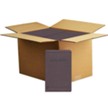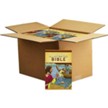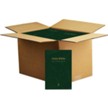2 Chronicles 3-4
Easy-to-Read Version
Solomon Builds the Temple
3 Solomon began building the Lord’s Temple at Jerusalem on Mount Moriah, where the Lord appeared to David, Solomon’s father. This was the place David had prepared for the Temple. It had been the threshing floor of Araunah[a] the Jebusite.[b] 2 Solomon started to build on the second day of the second month of his fourth year as king of Israel.
3 These are the measurements he used for building the foundation of God’s Temple, using the old cubit.[c] The foundation was 60 cubits[d] long and 20 cubits[e] wide. 4 The porch in front of the Temple was 20 cubits long and 20 cubits high.[f] He covered the inside of the porch with pure gold. 5 He put panels made of cypress wood on the walls of the larger room. Then he put pure gold over the cypress panels and then put pictures of palm trees and chains on the gold. 6 He put valuable stones in the Temple for beauty. The gold he used was gold from Parvaim.[g] 7 He covered the inside of the Temple with the gold. He put the gold on the ceiling beams, doorposts, walls, and doors. He carved Cherub angels on the walls.
8 Then he made the Most Holy Place. This room was 20 cubits long and 20 cubits wide. It was as wide as the Temple was. He put pure gold on the walls of the Most Holy Place. The gold weighed about 22 1/2 tons.[h] 9 The gold nails weighed 1 1/4 pounds.[i] He covered the upper rooms with gold. 10 He made two Cherub angels to put in the Most Holy Place. The workers covered the Cherub angels with gold. 11 Each wing of the Cherub angels was 5 cubits[j] long. The total length of the wings was 20 cubits. One wing of the first Cherub angel touched the wall on one side of the room. The other wing touched one wing of the second Cherub angel. 12 And the other wing of the second Cherub angel touched the wall on the other side of the room. 13 So the wings of the two Cherub angels together reached across the room—a total of 20 cubits. The Cherub angels stood facing the Holy Place.[k]
14 He made the curtain[l] from blue, purple, and red materials and expensive linen. There were Cherub angels on the curtain.
15 He put two columns in front of the Temple. The columns were 35 cubits[m] tall. The top part of the two columns was 5 cubits long. 16 He made chains in a necklace and put them on the tops of the columns. He made 100 pomegranates[n] and put them on the chains. 17 Then he put the columns up in front of the Temple. One column stood on the right side. The other column stood on the left side. He named the column on the right side “Jakin.”[o] And he named the column on the left side “Boaz.”[p]
Furniture for the Temple
4 He made a bronze altar that was 20 cubits[q] long, 20 cubits wide, and 10 cubits[r] tall. 2 Then he made a large tank[s] from melted bronze. It was round and it measured 10 cubits across from edge to edge. It was 5 cubits[t] tall and about 30 cubits[u] around. 3 There were images of bulls under the lip of the large bronze tank.[v] They were in two rows that went 10 cubits around the tank. The bulls were molded in place when the tank was shaped. 4 The large bronze tank was on top of twelve large statues of bulls. Three bulls looked toward the north. Three bulls looked toward the west. Three bulls looked toward the south. Three bulls looked toward the east. The large bronze tank was on top of these bulls. All the bulls stood with their rear ends to each other and to the center. 5 The large bronze tank was 3 inches[w] thick. The edge of the large tank was like the edge of a cup. The edge looked like a lily blossom. The tank could hold about 17,400 gallons.[x]
6 He made ten basins. He put five basins on the right side of the large bronze tank and five basins on the left side. These ten basins were to be used to wash the things offered for the burnt offerings. But the large bronze tank was to be used by the priests for washing before they offered sacrifices.
7 He made ten lampstands of gold. He followed the plans made for these lampstands. He put the lampstands in the Temple. There were five lampstands on the right side and five lampstands on the left side. 8 He made ten tables and put them in the Temple. Five tables were on the right side and five tables on the left side in the Temple. And he used gold to make 100 basins. 9 He also made the priests’ courtyard, the large courtyard, and the doors that open to them. He used bronze to cover these doors. 10 Then he put the large bronze tank on the right side of the Temple on the southeast side.
11 Huram also made the pots, shovels, and basins. So he finished his work for King Solomon on God’s Temple:
12-16 2 columns;
2 capitals shaped like bowls for the top of the columns;
2 nets to go around the capitals;
400 pomegranates for the two nets (two rows of pomegranates for each net to cover the two bowls for the capitals on top of the columns);
10 carts with a bowl on each cart;
the large tank with 12 bulls under it;
the pots, small shovels, small bowls, and all the dishes for the Lord’s Temple.
All the things that Huram made for King Solomon were made of polished bronze. 17 King Solomon first poured these things in clay molds. The molds were made in the Jordan Valley between the towns of Succoth and Zeredah. 18 Solomon made so many of them that no one tried to weigh the bronze used.
19 Solomon also made the dishes and things for God’s Temple. He made the golden altar and the tables where they put the bread of the Presence. 20 He made the lamps and lampstands of pure gold. These were put inside the Holy Place in front of the Most Holy Place. 21 He used pure gold to make the flowers, lamps, and tongs.[y] 22 He used pure gold to make the lamp snuffers, bowls, pans, and the censers.[z] He used pure gold to make the doors for the Temple, the inside doors for the Most Holy Place and the doors for the main hall.
Footnotes
- 2 Chronicles 3:1 Araunah In Hebrew, “Ornan.”
- 2 Chronicles 3:1 Jebusite A person who lived in Jerusalem before the Israelites took the city. “Jebus” was the old name for Jerusalem.
- 2 Chronicles 3:3 the old cubit This was the Egyptian cubit, measuring about 20 3/8" (51.83 cm).
- 2 Chronicles 3:3 60 cubits 102' 3/8" (31.1 m).
- 2 Chronicles 3:3 20 cubits 34' 1/8" (10.37 m). Also in verses 4, 8, 11, 13.
- 2 Chronicles 3:4 20 cubits high 34' 1/8" (10.37 m). Some of the Hebrew texts have “120 cubits high.”
- 2 Chronicles 3:6 Parvaim This was a place where there was much gold. It was probably in the country of Ophir.
- 2 Chronicles 3:8 22 1/2 tons Literally, “600 talents” (20,700 kg).
- 2 Chronicles 3:9 1 1/4 pounds Literally, “50 shekels” (575 g).
- 2 Chronicles 3:11 5 cubits 8' 6" (2.6 m). Also in verse 15.
- 2 Chronicles 3:13 facing the Holy Place Or “facing each other.” The Holy Place is the room in the Temple that was used by the priests to do their daily service to God.
- 2 Chronicles 3:14 curtain This curtain was a large piece of cloth that hung between the Holy Place and the Most Holy Place so that no one could see the Lord’s Box of the Agreement and Cherub angels that were in there.
- 2 Chronicles 3:15 35 cubits 59' 6 3/16" (18.14 m).
- 2 Chronicles 3:16 pomegranates Small bells shaped like pomegranates, a red fruit with many tiny seeds covered with a soft, juicy part of the fruit. Also in 4:13.
- 2 Chronicles 3:17 Jakin In Hebrew, Jakin seems to mean “he establishes.”
- 2 Chronicles 3:17 Boaz In Hebrew, Boaz seems to mean “in him is strength.”
- 2 Chronicles 4:1 20 cubits 34' 1/8" (10.37 m).
- 2 Chronicles 4:1 10 cubits 17' 1/16" (5.18 m).
- 2 Chronicles 4:2 large tank Literally, “sea.”
- 2 Chronicles 4:2 5 cubits 8' 6" (2.6 m).
- 2 Chronicles 4:2 30 cubits 51' 3/16" (15.55 m).
- 2 Chronicles 4:3 large bronze tank Literally, “sea.” Also in verses 10, 14.
- 2 Chronicles 4:5 3 inches Literally, “1 handbreadth” (7.4 cm).
- 2 Chronicles 4:5 17,400 gallons Literally, “3000 baths” (66,000 l).
- 2 Chronicles 4:21 tongs A tool used to hold hot coals.
- 2 Chronicles 4:22 censers Bowls used to carry fire.
Copyright © 2006 by Bible League International
Bible Gateway Recommends








